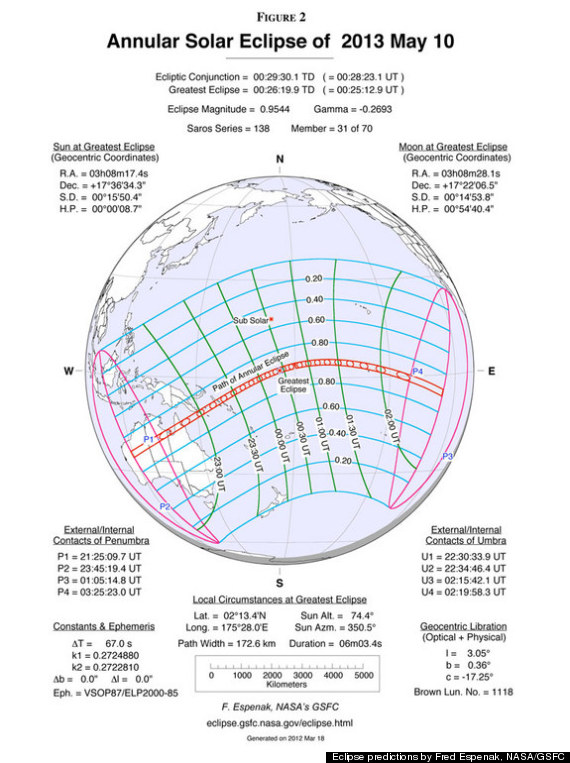
By: Miriam Kramer
Published: 05/06/2013 01:31 PM EDT on SPACE.com
The moon will block the sun in a potentially spectacular solar eclipse this week — a celestial event that will transform the sun into a cosmic "ring of fire" in the daytime sky.
The ring-shaped solar eclipse, known as an annular eclipse, will occur Thursday and Friday (May 9 and 10) Eastern time. Weather permitting, the eclipse will be visible in certain parts of Australia and the Southern Pacific Ocean, where the local time will be Friday.

The first solar eclipse of 2013 occurs at the Moon's descending node in eastern Ares. An annular eclipse will be visible from Australia, eastern Papua New Guinea, the Solomon Islands, and the Gilbert Islands.
"Solar eclipses can be inspirational to students and others, so it is interesting to have everyone view the eclipse, but only safe methods of viewing should be used," Jay Pasachoff, an astronomer at Williams College and chair of the International Astronomical Union's working group on eclipses, said in a statement. [See Spectacular Photos of a 'Ring of Fire' Solar Eclipse]
While nearly 95 percent of the sun will be covered by the moon at the eclipse's peak, the sky will not be noticeably darker to the naked eye at any point, explained Williams College officials in Williamstown, Mass.
For this reason, special protective lenses, camera and telescope filters and other methods of protection should be used in order to safely watch the eclipse even during full annularity, when the sun is silhouetting the moon.
The path of annularity passes through parts of Papua New Guinea, the Solomon Islands, and Western Australia, the Northern Territory and Queensland in Australia. Other nearby parts of the world will be able to see a partial solar eclipse, if weather permits.
The Hawaiian Islands, other parts of Australia, the southern Philippines, eastern Indonesia, other areas in Papua New Guinea and a small part of New Zealand will get at least a partial show, Williams College officials said.
The entire world should be able to catch a glimpse of the annular eclipse thanks to the online Slooh Space Camera. Slooh will host a webcast featuring expert commentary and views of the eclipse on Thursday starting at 5:30 p.m. EDT (2130 GMT). You can watch the broadcast live on SPACE.com.
During annular solar eclipses, the moon casts a shadow on the face of the Earth when it passes between the planet and the star. Because of its orbit, however, the moon still appears about 4.5 percent smaller than the sun, creating the distinct ring in the sky, Joe Rao, a SPACE.com contributor and meteorologist said.
This week's solar eclipse comes on the heels of a partial lunar eclipse that shadowed the moon above Central Asia, Western Australia, Eastern Europe and Africa. Another minor lunar eclipse will occur on May 24.
These aren't the only eclipses of 2013. On Nov. 3, a rare hybrid solar eclipse — an annular eclipse that transitions into a total eclipse — will be visible in the northern Atlantic Ocean and into equatorial Africa.
WARNING: Never look directly at the sun during an eclipse with a telescope or your unaided eye. Severe eye damage can result and scientists use special filters to safely view the sun.
Editor's note: If you live in the observing area of Thursday's solar eclipse and safely snap an amazing picture of the sun that you'd like to share for a possible story or image gallery, send photos, comments and your name and location to managing editor Tariq Malik at spacephotos@space.com.
Follow Miriam Kramer on Twitter and Google+. Follow us on Twitter, Facebook and Google+. Original article on SPACE.com.
